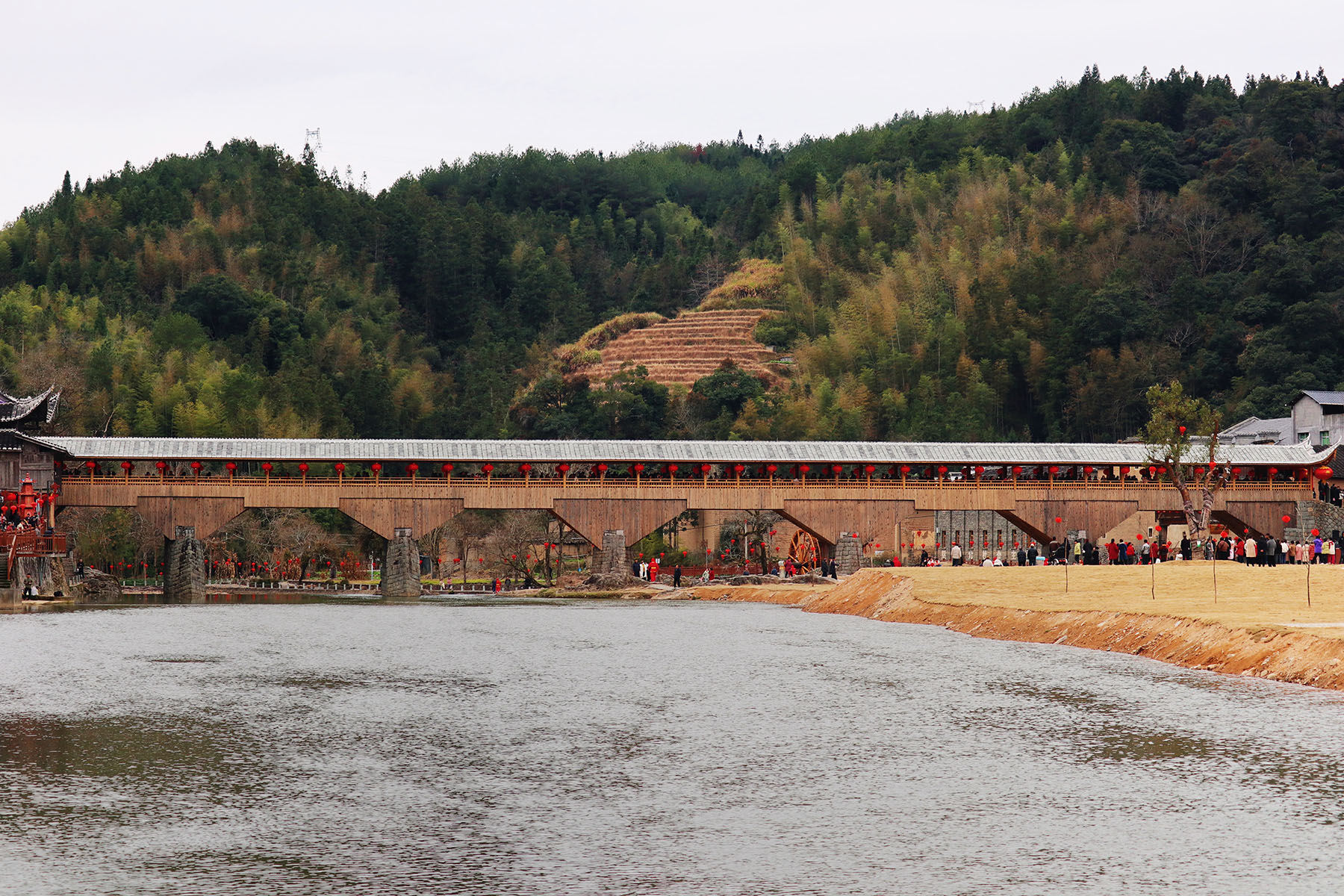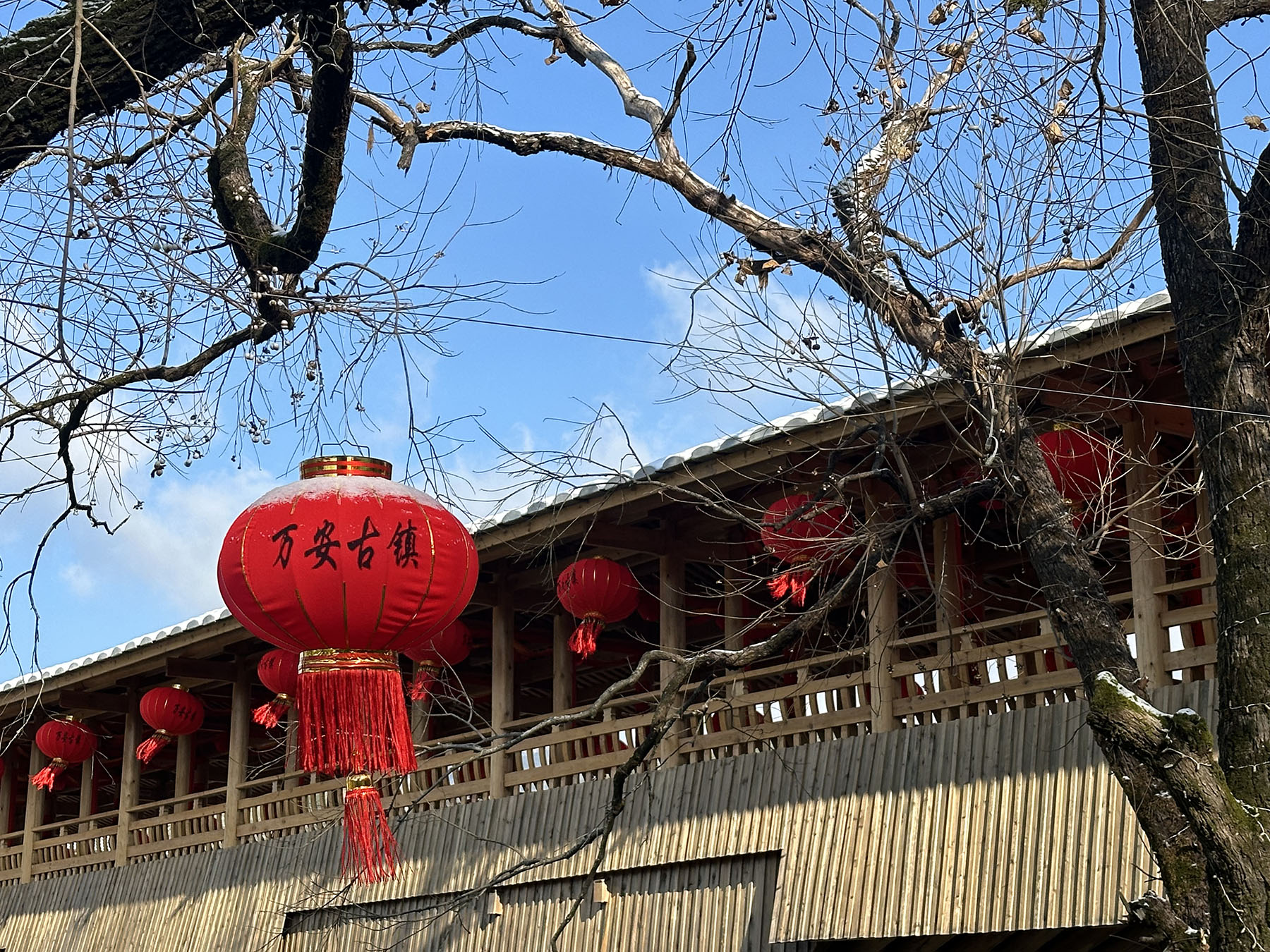Expertise, knowledge of making ornate covered wooden structures still alive, Wang Ru reports in Ningde, Fujian province.

When Huang Minhui, 41, a city-level inheritor of wooden-arch bridge construction, heard in 2022 that Wan'an Bridge, which embodied the efforts of four generations of his family, had been damaged in a fire, he was heartbroken and his father, Huang Chuncai, 88, a national-level inheritor of the craft, had difficulty sleeping.
The Huang family has a deep bond with the old bridge, which was originally built during the Northern Song Dynasty (960-1127) and is the longest covered wooden-arch bridge in China.
The structure has suffered misfortune before and the family has always responded. In 1932, it was severely damaged in a fire, and Huang Minhui's great-grandfather and grandfather restored it. In 1952, when the bridge was partly destroyed in a flood, his grandfather and father were the main craftsmen involved in its restoration. Then in 2016, it was again restored by his father, his elder brother Huang Minping, and Huang Minhui himself.
Then, in 2022 there was the fire.
READ MORE: The delicacy is in the details
He and his brother played key roles in the six-month restoration project launched by the local government in July last year, leading to the bridge being reopened to the public.
During a meeting for the Three-Year Action Plan for the Protection of Covered Bridges (2023-25) in Pingnan county, Ningde, Fujian province, last month, Wan'an Bridge was highlighted as an example of technology meeting craftsmanship, and a drill was held to demonstrate the bridge's upgraded fire emergency mechanisms.
Spanning over the Changqiao Stream, the bridge links the villages of Changqiao and Changxing on either bank. It is an outstanding example of a wooden-arch bridge, a type of covered structure popular in northern Fujian and southern Zhejiang province, according to Lu Zeqi, an expert in cultural heritage in Pingnan.
Built out of interlocking short beams to create an arch without nails or rivets, its body is like an upside-down basket, and the resulting structure is able to efficiently spread weight loads.
"Using short logs, it's possible to make long bridges. This is a reflection of the skill of the people in the mountainous areas of Fujian and Zhejiang," Lu says.

Restoring the old
Chen Juan, Party secretary of Changqiao town, where the bridge is located, says that Wan'an Bridge is still an important traffic artery, and it is a meeting place for people to gather to chat, relax and have fun, and that for those who have moved away, it is an emblem of home.
Unlike some historical buildings, which were privately owned, covered bridges were always public structures. Consequently, their construction was a collaborative effort, with local communities pooling funds. The donations were viewed as "acts of prayer" and wishes for health and happiness, Chen says.
Wan'an Bridge was no exception. A tablet inlaid in one of its stone piers details a donation made in 1090 by a man called Jiang Zhen, who donated the money and millet to build the pier.
Chen says that the restoration last year was based on information collected during a census of Pingnan's cultural heritage in 2019, construction sketches belonging to the Huang family, and the support of an ancient building institute in Zhejiang.
"Luckily, the building techniques haven't been lost and there are inheritors of the craft," Chen says. "They decided not to change the original facade and features, and restored it using traditional techniques. Modern tools help in some areas, like sawing components, but most things were still done by hand."
She says although the bridge was badly damaged, key components survived. Local residents found them in the river and fished them out. In the act of restoration, the old components were reused and became part of the restored bridge.
"From the cultural heritage protection perspective, we want to reuse old components to preserve their history as much as possible. We make sure they are still safe enough to reuse and their inclusion symbolizes the continuation of the past, and serves as a warning to people not to neglect the safety of the bridge," Chen says.
Local residents donated 4.4 million yuan ($614,400) to the restoration, on top of funding from the government, and were invited to a banquet after the bridge was restored.
Chen says that they have analyzed the threats to the safety of the bridge: fire, floods, human-made damage and pests, and have taken measures to respond to them.
This includes installing alarms on the bridge to monitor for fire hazards, like smoking, and arranging for it to be patrolled 24 hours a day. Additionally, the bridge is regularly disinfected and sterilized to protect against pests.
Awareness of protection has improved. According to Chen, local residents have set up a center in the hopes of protecting their hometown.
Activities such as sports meetings for farmers, poetry recitation events, and study tours, have also been held to integrate the bridge into the area's development of tourism, and Chen says that during the Spring Festival holiday between Feb 10 and 15, it received about 10,000 visits every day.
A family inheritance
The Huang family's dedication to building and restoring wooden arch bridges began with Huang Minhui's great-grandfather Huang Jinshu, who learned the craft from Zhuo Maolong, a well-known bridge builder during the late Qing Dynasty (1644-1911).
In Pingnan, people often built wooden bridges as the area is mountainous and has an abundance of trees. Bridge-making was a way of making a living, and covered bridges also provided shelter from frequent rain, permitting people to meet outdoors in a public space and protecting the wooden bridge body.
According to Huang Minhui, Zhuo had many apprentices but most left after he fell ill. His great-grandfather, Huang Jinshu, took care of Zhuo and continued to learn bridge-building skills from him. When Zhuo was too sick to get out of bed, he continued to teach by constructing model bridges using chopsticks. When Zhuo passed away, the Huang family buried him as he had no children of his own.
"The intricate techniques for making wooden arch bridges were already well-tested when master Zhuo imparted the skills to my great-grandfather," says Huang Minhui.
On one side of the Wan'an Bridge lies Dasheng Temple, which survived the 2022 fire. The stage in it is said to have been built by Zhuo. The temple is dedicated to the Monkey King, an iconic figure in Chinese classics, who is famous for his heroic efforts to dispel evildoers, and who residents believe protects them.
The way Huang Minhui remembers it, his father Huang Chuncai was an ordinary carpenter, and the Wan'an Bridge was like an old friend. He was amazed by its structure, but had no idea of its relationship with his family, nor of his father's ability to build bridges, as wooden bridges were gradually replaced by concrete and steel in the 1960s and his father Huang Chuncai left home in search of work.
Huang Chuncai had only started learning to make wooden bridges from his father when he was 15 but by the time he was 20, he was the main designer and builder behind one local bridge, which made him a name in the trade. But after building another bridge in Ningde's Gutian county in 1969, he had no further requests, so he had to find other work.
ALSO READ: Reading between the lines
This suspension continued until 2004, when there was a project involving the historical Jinzao Bridge. People found the name of Huang Minhui's grandfather on the bridge and set out to find his descendants. Huang Chuncai was nearly 70 at the time but he once again came to attention for his proficiency, and was made an inheritor of the craft, which was listed as a form of national-level intangible cultural heritage in 2008.
In 2005, and then working in a factory in Shenzhen, Guangdong province, Huang Minhui was persuaded to return home to pick up his father's skills. "He said the craft should not be lost and needed to be passed on. I returned home and learned it from him with my brother," Huang Minhui says.
In recent years, local government has placed greater importance on wooden bridges and has asked the Huang family to build and restore a series of them. Huang Minhui and his brother built almost one bridge a year between 2005 and 2015 and honed their skills.
"Now, we most often make wooden bridges in tourist attractions, features in the landscape that are not necessarily useful. But Wan'an Bridge is still one of the most functional bridges in the area," he says.
Contact the writer at wangru1@chinadaily.com.cn


